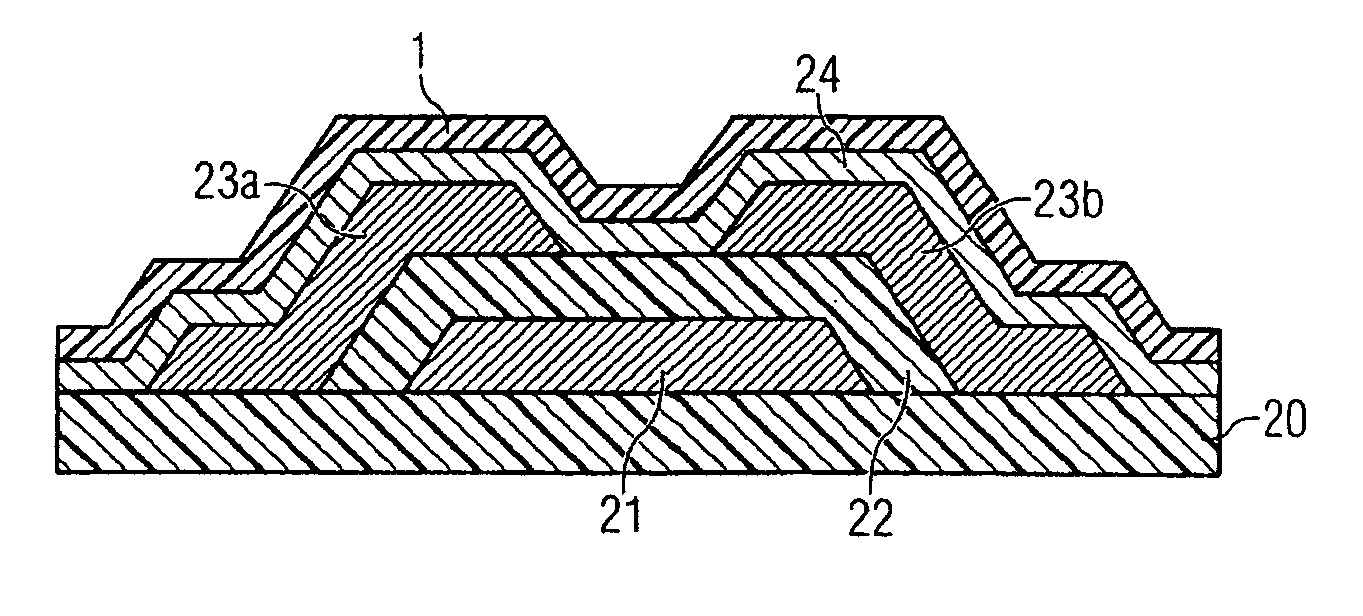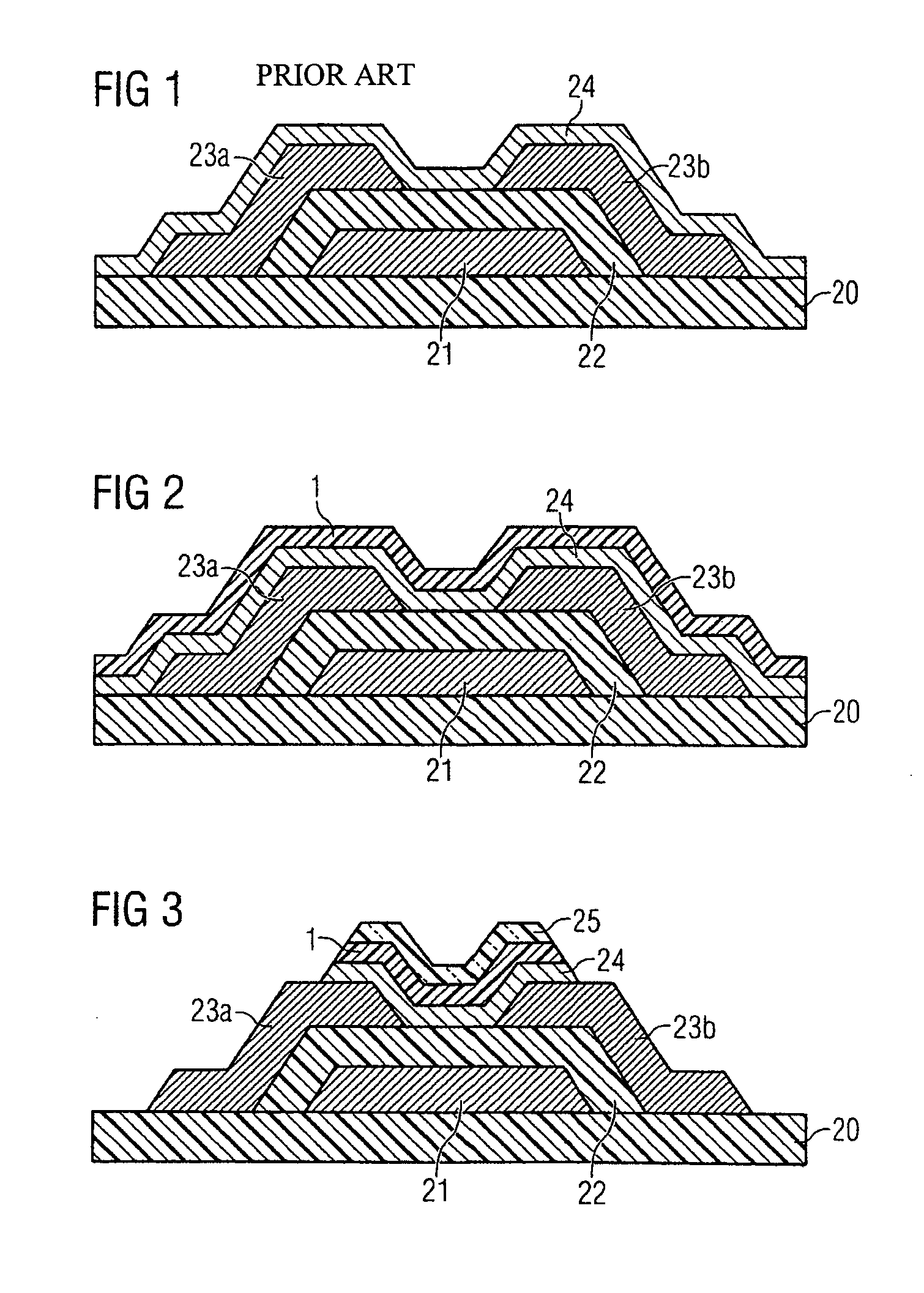Semiconductor component having at least one organic semiconductor layer and method for fabricating the same
a technology of organic semiconductor and semiconductor layer, which is applied in the direction of solid-state devices, coatings, chemical vapor deposition coatings, etc., can solve the problems of inability to produce circuits that are able to function correctly, difficult to design integrated circuits based on organic transistors, and limited options for providing organic semiconductor layers with a protective layer that protects the semiconductor layers from environmental influences, in particular moisture, to achieve the effect of low cost and high resistance to moistur
- Summary
- Abstract
- Description
- Claims
- Application Information
AI Technical Summary
Benefits of technology
Problems solved by technology
Method used
Image
Examples
example 1
Application of a Protective Paraffin Layer from the Vapor Phase.
[0056] A freshly produced semiconductor component (transistors and integrated circuits based on organic semiconductors on any desired substrates), in which an organic semiconductor layer 24 (e.g., pentacene) was deposited in the last process step (see for example, FIG. 1) is introduced into a vacuum vaporizer with substrate cooling. The temperature of the substrate holder is controlled to 25-50° C. (preferably 25° C.). Depending on the substrate size, the vaporizer source is loaded with a maximum of 1 g of paraffin wax (solidification point 73-80° C.—Aldrich) and then evacuated. The source is heated at a pressure of 10−2 to 10−4 torr (preferably 10−3 torr). The paraffin sublimes at a temperature of at most 200° C. (preferably 120 to 150° C.) and is deposited as a protective layer 1 on the cooled substrate. The layer thickness of the protective layer 1 can be set by means of the duration of vaporization (preferably 50 n...
example 2
Subsequent Processes Carried out on the Protective Paraffin Layer (Patterning of the Organic Semiconductor Layer).
[0057] A semiconductor component is provided with a protective layer 1 of paraffin in the same way as in Example 1. Then, an aqueous PVA / ADC formulation (see the article by Sheraw et al., cited above and incorporated herein by reference) is spun on (see FIG. 3, PVA layer 25), exposed using a photomask and developed in water. Then, the paraffin layer and the organic semiconductor layer 24 are etched in an oxygen plasma, with the UV-cured PVA layer 25 serving as an etching mask. Alternatively, the PVA etching mask can be printed onto the paraffin layer and cured by floodlight exposure.
example 3
Reducing the Influence of Moisture on the Subthreshold Swing and the On / Off Ratio
[0058] The effect of the exemplary embodiments according to the invention is demonstrated on the basis of measured values.
[0059] Two substrates (of which substrate A was coated with a protective layer 1 comprising paraffin as described in Example 1 and substrate B was left untreated) were stored for 10 days under 75% atmospheric humidity. The substrates were measured electrically before (e.g., FIG. 4A for Bfresh) and after storage (FIG. 4B for A and FIG. 4C for B). The drain current is in each case plotted against the gate-source voltage for a given drain-source voltage. The subthreshold swing and the on / off ratio of the transistors can be determined from this curve. Whereas, with substrate B a considerable deterioration was observed as a result of the action of moisture, the characteristic curve of substrate A remained virtually unchanged.
PUM
| Property | Measurement | Unit |
|---|---|---|
| thick | aaaaa | aaaaa |
| thick | aaaaa | aaaaa |
| temperature | aaaaa | aaaaa |
Abstract
Description
Claims
Application Information
 Login to View More
Login to View More - R&D
- Intellectual Property
- Life Sciences
- Materials
- Tech Scout
- Unparalleled Data Quality
- Higher Quality Content
- 60% Fewer Hallucinations
Browse by: Latest US Patents, China's latest patents, Technical Efficacy Thesaurus, Application Domain, Technology Topic, Popular Technical Reports.
© 2025 PatSnap. All rights reserved.Legal|Privacy policy|Modern Slavery Act Transparency Statement|Sitemap|About US| Contact US: help@patsnap.com



